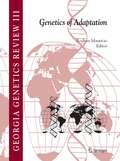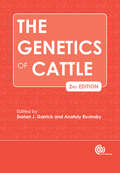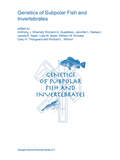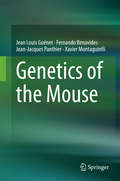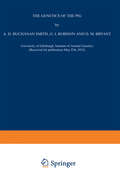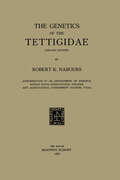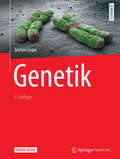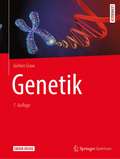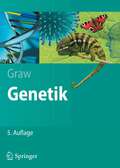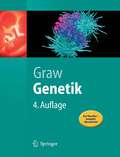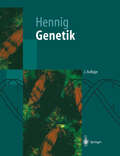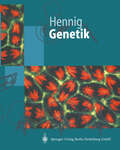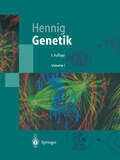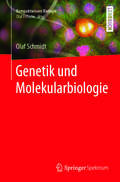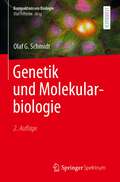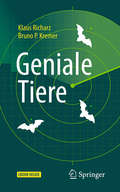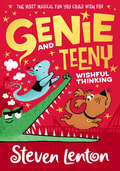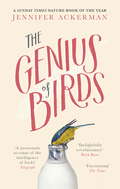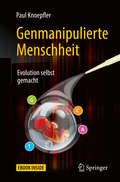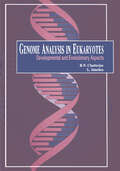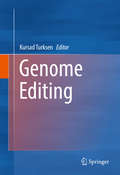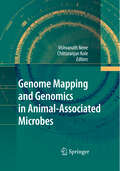- Table View
- List View
Genetics of Adaptation (Georgia Genetics Review #3)
by Rodney MauricioAn enduring controversy in evolutionary biology is the genetic basis of adaptation. Darwin emphasized "many slight differences" as the ultimate source of variation to be acted upon by natural selection. In the early 1900’s, this view was opposed by "Mendelian geneticists", who emphasized the importance of "macromutations" in evolution. The Modern Synthesis resolved this controversy, concluding that mutations in genes of very small effect were responsible for adaptive evolution. A decade ago, Allen Orr and Jerry Coyne reexamined the evidence for this neo-Darwinian view and found that both the theoretical and empirical basis for it were weak. Orr and Coyne encouraged evolutionary biologists to reexamine this neglected question: what is the genetic basis of adaptive evolution? In this volume, a new generation of biologists have taken up this challenge. Using advances in both molecular genetic and statistical techniques, evolutionary geneticists have made considerable progress in this emerging field. In this volume, a diversity of examples from plant and animal studies provides valuable information for those interested in the genetics and evolution of complex traits.
Genetics of Cattle, The
by Dorian J. Garrick Anatoly RuvinskySince the time of domestication more than 10,000 years ago, cattle have played an increasingly crucial role in the development of human civilizations. Progress has been quite remarkable since the turn of the century; the sequencing of the bovine genome in 2009 launched new avenues for furthering our understanding of theoretical and practical aspects of cattle genetics. Covering a vast array of questions, this book reviews major topics from molecular and developmental genetics, disease resistance and immunogenetics to genetic improvement of dairy and beef breeds, addressing all current problems in the field. This second edition includes a new team of authors and completely new chapters on the genetics of fat production, nutrition, feed intake and efficiency, growth and body composition. Fully updated throughout, it provides a valuable resource on cattle genetics for researchers, breeders, veterinarians and postgraduate students.
Genetics of Subpolar Fish and Invertebrates (Developments in Environmental Biology of Fishes #23)
by Anthony J. Gharrett Richard G. Gustafson Jennifer L. Nielsen James E. Seeb Lisa W. Seeb William W. Smoker Gary H. Thorgaard Richard L. WilmotFisheries genetics researchers will find invaluable the thirty-eight peer-reviewed contributions in this book, presented at the 20th Lowell Wakefield Fisheries Symposium "Genetics of Subpolar Fish and Invertebrates," held in May 2002 in Juneau, Alaska. Looming over concerns of lost fisheries stocks and persistent erosion of genetic variability are predictions of global warming, which may further tax genetic resources. One consequence is an increased reliance on genetic applications to many aspects of fisheries management, aquaculture, and conservation. The contributions in this book are important to modern fisheries science and genetics, and illustrate the evolution of the field over the past decade. The improved technology provides tools to address increasingly complicated problems in traditional applications and ecological and behavioral studies. The union between molecular and quantitative genetics, where many of the major questions about population structure and evolution remain unanswered, will also benefit from the new technologies.
Genetics of the Mouse
by Jean Louis Guénet Fernando Benavides Jean-Jacques Panthier Xavier MontagutelliThis book, written by experienced geneticists, covers topics ranging from the natural history of the mouse species, its handling and reproduction in the laboratory, and its classical genetics and cytogenetics, to modern issues including the analysis of the transcriptome, the parental imprinting and X-chromosome inactivation. The strategies for creating all sorts of mutations, either by genetic engineering or by using mutagens, are also reviewed and discussed in detail. Finally, a last chapter outlines the methodology used for the analysis of complex or quantitative traits. The authors also discuss the importance of accurate phenotyping, which is now performed in the mouse clinics established worldwide and identify the limits of the mouse model, which under certain circumstances can fail to present the phenotype expected from the cognate condition in the human model. For each chapter an up-to-date list of pertinent references is provided. In short, this book offers an essential resource for all scientists who use or plan to use mice in their research.
Genetik: Die Abbildungen Des Buches (Springer-Lehrbuch)
by Jochen GrawVon Mendel bis zu Genomforschung und Gentechnologie reicht dieses Standardwerk der Genetik. In der 6. Auflage um ein Kapitel zur Epigenetik und um Fragen und Antworten ergänzt sowie aktualisiert, bietet dieses Lehrbuch eine umfassende Darstellung der klassischen und der molekularen Genetik. Cytogenetik, Entwicklungsgenetik, Humangenetik und Anthropologie sowie Neuro- und Verhaltensgenetik sind weitere wichtige Inhalte. Technikboxen bereichern das umfassende Themen- und Methodenspektrum des Buches. Dieses Buch vermittelt genetisches Grundlagenwissen für das gesamte Studium. Dabei unterstützen zahlreiche hervorgehobene Lernhilfen und Beispiele aus allen Bereichen der Genetik sowie farbige Abbildungen.
Genetik
by Jochen GrawVon Mendel bis zu Genomforschung und Gentechnologie reicht dieses Standardwerk der Genetik. Es ist klar strukturiert und bietet eine umfassende Darstellung der klassischen und der molekularen Genetik. Cytogenetik, Entwicklungsgenetik, Humangenetik und Anthropologie sowie Neuro- und Verhaltensgenetik sind weitere wichtige Inhalte. Komplexe Sachverhalte werden verständlich und auf dem aktuellen wissenschaftlichen Stand dargestellt. Technikboxen bereichern das umfassende Themen- und Methodenspektrum. Dieses Buch vermittelt genetisches Grundlagenwissen für das gesamte Studium. Dabei unterstützen zahlreiche hervorgehobene Lernhilfen und Beispiele aus allen Bereichen der Genetik, ansprechende, farbige Abbildungen sowie Übungsfragen. Die 7. Auflage wurde gründlich überarbeitet und aktualisiert sowie mit Links zu erklärenden Videos zu besonderen Aspekten des jeweiligen Kapitels ergänzt.
Genetik (Springer-Lehrbuch)
by Jochen GrawDer Band bietet eine umfassende und präzise Darstellung der klassischen wie der modernen Genetik: Entwicklungsbiologie und –genetik, Humangenetik, Neuro- und Verhaltensgenetik sowie Chromosomenforschung. Für die 5. Auflage wurde das Lehrbuch grundlegend überarbeitet und aktualisiert. Es beinhaltet das Grundlagenwissen der Genetik für das gesamte Studium. Die Inhalte werden durch zahlreiche Lernhilfen und Beispiele aus allen Bereichen der Genetik vermittelt. Alle Abbildungen sind im Internet frei verfügbar.
Genetik (Springer-Lehrbuch)
by Jochen GrawGrundlegend überarbeitet und aktualisiert bietet dieses Lehrbuch in der 4. Auflage eine umfassende Darstellung der klassischen und der molekularen Genetik, von Mendel bis zu Genomforschung und Gentechnologie.
Genetik (Springer-Lehrbuch)
by Wolfgang HennigAktuell überarbeitet und erweitert bietet der "Hennig" eine umfassende Darstellung der klassischen und molekularen Genetik von den Mendelschen Regeln über die Chromosomenforschung bis hin zur Entwicklungsbiologie, Humangenetik und Gentechnologie: Genetisches Grundlagenwissen für das gesamte Studium. Ein neues Kapitel zum Thema Human Genom Forschung erweitert das aktuelle Themen- und Methodenspektrum des Buches. Die Kapitel zu Humangenetik und Gentechnologie wurden mit Hinblick auf den aktuellen Wissensstand überarbeitet und ergänzt. Die Inhalte werden durch zahlreiche hervorgehobene Lernhilfen und Beispiele aus allen Bereichen der Genetik optimal vermittelt. Ausführliche Literaturangaben ermöglichen den Zugang auch zu Originalarbeiten.
Genetik (Springer-Lehrbuch)
by Wolfgang HennigWas ist Genetik? Wer in die Thematik einsteigen möchte, findet hier die Antwort. Ausführlich und aktuell werden Grundlagen und Zusammenhänge, Fakten und Trends beschrieben. Verständlich und anschaulich sind die Informationen zusammengestellt. Durchgehend vierfarbige, lerngerecht gestaltete Seiten mit zahlreichen Abbildungen bieten nicht nur fundiertes Wissen, sondern reines Lesevergnügen. Concise text: Was ist Genetik? Ausführlich und aktuell werden Grundlagen und Zusammenhänge, Fakten und Trends beschrieben. Die anschauliche Darstellung bietet nicht nur fundiertes Wissen, sondern reines Lesevergnügen.
Genetik und Molekularbiologie (Kompaktwissen Biologie)
by Martin Lay Olaf SchmidtDie Reihe Kompaktwissen präsentiert in klarer, prägnanter Darstellung die Inhalte biologischer Fachgebiete. Ohne unnötigen Ballast und im richtigen Kontext erläutert jeder Band verständlich die Fakten, Zusammenhänge und Prinzipien eines Teilgebiets der Lebenswissenschaften. Damit eignet sich die Reihe besonders… zur Nachbereitung von Vorlesungen und Seminaren … zur Vorbereitung auf Prüfungen… zum Nachschlagen während des späteren Studiums oder im Berufsleben. Das Wichtigste zur Genetik und ihrer Molekularbiologie von Pro- und EukaryotenDas gesamte Wissen zur Genetik für die Prüfungen bis zum Bachelor oder ersten Staatsexamen in kompakter Form: Das genetische Material Organisation des Erbgutes DNA-Replikation Transkription und Translation bei Bakterien, Archaeen und Eukaryoten Regulation der Genexpression bei Prokaryoten Formale Genetik, Klassische Genetik Rekombination, Variabilität Konjugation, Transduktion, Transformation bei Bakterien Mutationen DNA-Reparaturmechanismen Humangenetik Immun- und Entwicklungsgenetik Genomik Methoden: von DNA-Isolierung bis Genome editing Modellorganismen
Genetik und Molekularbiologie (Kompaktwissen Biologie)
by Olaf G. SchmidtDer Espresso unter den LehrbüchernKompaktwissen Genetik und Molekularbiologie präsentiert die Inhalte in klarer, prägnanter Darstellung. Ohne unnötigen Ballast und im richtigen Kontext erläutert der Band verständlich die Fakten, Zusammenhänge und Prinzipien dieses wichtigen Teilgebiets der Lebenswissenschaften. Damit eignet er sich besonders… zur Nachbereitung von Vorlesungen und Seminaren … zur Vorbereitung auf Prüfungen… zum Nachschlagen während des späteren Studiums oder im Berufsleben. Das Wichtigste zur Genetik und ihrer Molekularbiologie von Pro- und Eukaryoten Das gesamte Wissen zur Genetik für die Prüfungen bis zum Bachelor oder ersten Staatsexamen in kompakter Form:Das genetische MaterialOrganisation des ErbgutsDNA-ReplikationTranskription und Translation bei Bakterien, Archaeen und EukaryotenRegulation der Genexpression bei ProkaryotenRegulation der Genexpression bei EukaryotenFormale Genetik, Klassische GenetikRekombination, VariabilitätKonjugation, Transduktion, Transformation bei BakterienMutationenDNA-ReparaturmechanismenHumangenetikImmun- und EntwicklungsgenetikGenomikMethoden: von DNA-Isolierung bis Genome Editing und Organ-ChipsModellorganismenDie zweite Auflage wurde durchgehend überarbeitet und um aktuelle Inhalte ergänzt. Erweitert wurden vor allem die Darstellungen zur Architektur des Genoms, seiner Kontrolle und Regulation und die Bedeutung epigenetischer Vorgänge.
Geniale Tiere: Anekdotisches, Bewundernswertes und Erstaunliches aus allen Bereichen unserer Fauna
by Klaus Richarz Bruno P. KremerVom mikroskopisch kleinen Lebewesen bis zum großen Vierbeiner versetzen uns die meisten Tiere in Erstaunen: Sie können tiefer tauchen, schneller schwimmen, besser laufen oder gar ausdauernd fliegen – physische Leistungsmerkmale, die uns in dieser Perfektion weitgehend fehlen. Noch erstaunlicher sind ihre sensorischen Fähigkeiten: Wer kann schon mit den Ohren sehen oder seine Auserwählte aus einer Distanz von rund 10 km nur mit dem Geruchssinn wahrnehmen? Dieses Buch berichtet über bewundernswerte Eigenheiten und Fähigkeiten von Tieren aller größeren Verwandtschaftsgruppen: Staunen Sie über das reiche Leben zwischen den Sandkörnern des Strandes. Wundern Sie sich über Bienen, die in leeren Schneckenhäusern wohnen. Oder haben Sie je von Tieren gehört, die mit den Füßen fischen? Weitere spannende Themen sind lärmende Meeresfische, dreiäugige Echsen, giftige Vögel und Fledermäuse im Rotlichtmilieu. Mit diesem Wissen wird Ihnen der Gesprächsstoff bei keiner Gelegenheit ausgehen.
Genie and Teeny 2-book Collection Volume 1 (Genie and Teeny)
by Steven LentonMeet Grant the genie, and his best friend – the puppy, Teeny… The first two books in a series of magical adventures from the renowned illustrator, Steven Lenton, winner of Waterstones Picture Book of the Month and the Times Children’s Book of the Week.
Genie and Teeny 2-book Collection Volume 2 (Genie and Teeny)
by Steven LentonGrant the genie, and his best friend – the puppy, Teeny, are back . . . The second two books in a series of magical adventures from the renowned illustrator, Steven Lenton, winner of Waterstones Picture Book of the Month and The Times Children’s Book of the Week.
Genie and Teeny: Wishful Thinking (Genie and Teeny #2)
by Steven LentonMeet Grant the genie, and his best friend – the puppy, Teeny… The second in a series of magical adventures from the renowned illustrator, Steven Lenton, winner of Waterstones Picture Book of the Month and the Times Children’s Book of the Week.
Genie and Teeny: The Wishing Well (Genie and Teeny #3)
by Steven LentonMeet Grant the genie, and his best friend – the puppy, Teeny… The third in a series of magical adventures from the renowned illustrator, Steven Lenton, winner of Waterstones Picture Book of the Month and the Times Children’s Book of the Week.
The Genius of Birds: The Intelligent Life of Birds
by Jennifer AckermanBirds are astonishingly intelligent creatures. In fact, according to revolutionary new research, some birds rival primates and even humans in their remarkable forms of intelligence. Like humans, many birds have enormous brains relative to their size. Although small, bird brains are packed with neurons that allow them to punch well above their weight.In The Genius of Birds, acclaimed author Jennifer Ackerman explores the newly discovered brilliance of birds and how it came about. As she travels around the world to the most cutting-edge frontiers of research - the distant laboratories of Barbados and New Caledonia, the great tit communities of the United Kingdom and the bowerbird habitats of Australia, the ravaged mid-Atlantic coast after Hurricane Sandy and the warming mountains of central Virginia and the western states - Ackerman not only tells the story of the recently uncovered genius of birds but also delves deeply into the latest findings about the bird brain itself that are revolutionizing our view of what it means to be intelligent.Consider, as Ackerman does, the Clark's nutcracker, a bird that can hide as many as 30,000 seeds over dozens of square miles and remember where it put them several months later; the mockingbirds and thrashers, species that can store 200 to 2,000 different songs in a brain a thousand times smaller than ours; the well-known pigeon, which knows where it's going, even thousands of miles from familiar territory; and the New Caledonian crow, an impressive bird that makes its own tools.But beyond highlighting how birds use their unique genius in technical ways, Ackerman points out the impressive social smarts of birds. They deceive and manipulate. They eavesdrop. They display a strong sense of fairness. They give gifts. They play keep-away and tug-of-war. They tease. They share. They cultivate social networks. They vie for status. They kiss to console one another. They teach their young. They blackmail their parents. They alert one another to danger. They summon witnesses to the death of a peer. They may even grieve.This elegant scientific investigation and travelogue weaves personal anecdotes with fascinating science. Ackerman delivers an extraordinary story that will both give readers a new appreciation for the exceptional talents of birds and let them discover what birds can reveal about our changing world.
Genmanipulierte Menschheit: Evolution selbst gemacht
by Paul Knoepfler Martina WieseDieses Buch erläutert die neusten Technologien im Bereich Genmanipulation, Gentherapie und Klonierungen, insbesondere auch beim Menschen, die in den kommenden Jahren zunehmend in der Praxis eingesetzt werden könnten. Der Fortschritt in Gebieten wie Genetik, Reproduktionsmedizin und Stammzellforschung über die letzten Jahre hat die Erschaffung einer neuen Art von „Mensch“ in greifbare Nähe gerückt. Allerdings gehen die Meinungen über Genmanipulation am Menschen sehr weit auseinander – von Organisationen, die sie stark befürworten, bis hin zu Gegnern, die sie zutiefst ablehnen. Zugleich befindet sich der Großteil der Gesellschaft in Unwissenheit darüber, dass wir uns unmittelbar vor einem Wendepunkt der Menschheitsgeschichte befinden, an dem wir selbstbestimmt darüber entscheiden können, was „Mensch sein“ im biologischen Sinne zukünftig bedeutet. Über genmanipulierte Nahrungsmittel und Organismen ist die Öffentlichkeit im Allgemeinen bereits gut informiert. Das vorliegende Buch soll die Leser nun über das Potenzial und die Gefahren der sich anbahnenden Genmanipulation beim Menschen aufklären. Es will dazu beitragen, das Thema stärker ins Licht der Öffentlichkeit zu rücken und eine breite und fundierte Diskussion darüber in Gang zu bringen.
Genome Analysis in Eukaryotes: Developmental and Evolutionary Aspects
by Rabindra N. Chatterjee Lucas SanchezDuring the last decades a breakthrough in the understanding of the mechanisms controlling development has been achieved. This has been possible, in great part, by the use of various experimental approaches.This book focuses on topics concerning some of the processes involved in development, the main emphasis being on the genetic and molecular mechanisms in the evolutionary context. Drosophila is used as an experimental model for the genetic approach to the understanding of behaviour.
Genome Editing
by Kursad TurksenThis timely volume explores the use of CRISPR-Cas9 for genome editing, presenting cutting-edge techniques and their applications in treatment of disease. The chapters describe latest methods such as use of targetable nucleases, investigation of the non-coding genome, mouse genome editing, increasing of knock-in efficiency in mouse zygotes, and generation of reporter stem cells; the text contextualizes these methods in treatment of cardiovascular disease, diabetes mellitus, retinitis pigmentosa, and others. The final chapters round out the book with a discussion of controversies and future directions.Genome Editing is an essential, of-the-moment contribution to this rapidly growing field. Drawing from a wealth of international perspectives, it presents novel techniques and applications for the engineering of the human genome. This book is essential reading for all clinicians and researchers in stem cells, regenerative medicine, genomics, biochemical and biomedical engineering- especially those interested in learning more about genome editing and applying it in a targeted, specific way.
Genome Mapping and Genomics in Animal-Associated Microbes
by Vishvanath Nene Chittaranjan KoleAchievements and progress in genome mapping and the genomics of microbes supersede by far those for higher plants and animals, in part due to their enormous economic implication but also smaller genome size. In the post-genomic era, whole genome sequences of animal-associated microbes are providing clues to depicting the genetic basis of the complex host-pathogen relationships and the evolution of parasitism; and to improving methods of controlling pathogens. This volume focuses on a globally important group of intracellular prokaryotic pathogens which affect livestock animals. These include Brucella, Mycobacterium, Anaplasma and Ehrlichia, as well as the protozoan pathogens Cryptosporidium and Theileria, for which genome sequence data is available. Insights from comparative genomics of the microbes described provide clues to the adaptation involved in host-microbe interactions, as well as resources potentially useful for application in future research and product development.
